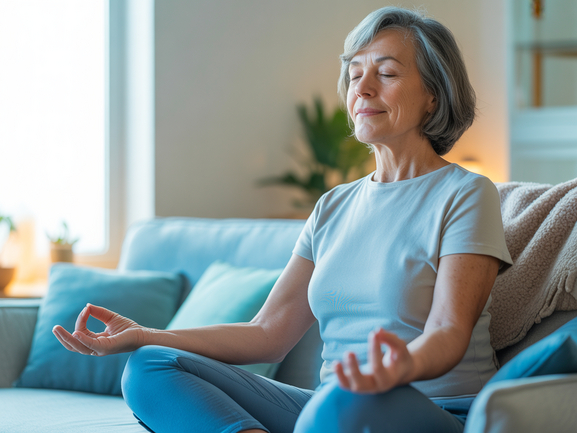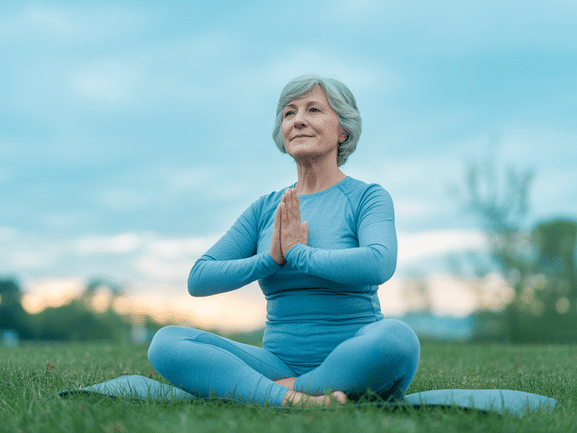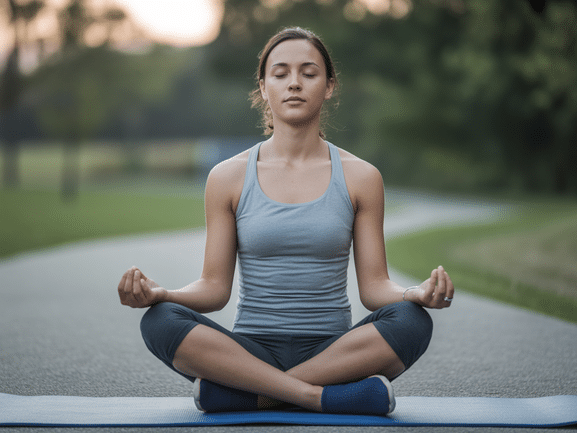The Definitive Guide to Meditation for Seniors
As we age, finding sustainable ways to nurture our mental and physical health becomes a top priority. Among the most powerful and accessible tools available is meditation for seniors. This practice, far from being complex or esoteric, involves simple, gentle techniques adapted for older adults to enhance focus, calm the mind, and improve overall well-being—all without needing special equipment or flexibility.
If you’ve ever thought that meditation was not for you, this guide is here to change your mind. We will walk you through the science-backed benefits of mindfulness for older adults and provide five easy-to-follow exercises. Discover how starting a senior meditation practice, whether you’re 60, 70, or beyond, can cultivate profound peace and resilience in your daily life.

Why Meditation is a Game-Changer in Your Golden Years
Embracing a consistent meditation practice offers a wealth of benefits that can significantly enhance your quality of life. As we navigate the changes that come with aging, mindfulness provides a powerful tool for managing both mind and body. The advantages are not just anecdotal; they are backed by a growing body of scientific research.
According to a study published in the Annals of the New York Academy of Sciences, mindfulness-based stress reduction can lead to measurable decreases in anxiety and improvements in cognitive function in older adults. This highlights how meditation for seniors is a vital tool for healthy aging.
Key Benefits of Mindfulness for Older Adults:
- Enhanced Cognitive Function: The brain’s ability to adapt and form new neural pathways, known as neuroplasticity, continues throughout life. Regular meditation acts as a workout for the brain, helping to sharpen focus, improve memory retention, and maintain mental clarity.
- Significant Stress and Anxiety Reduction: Mindfulness teaches you to observe thoughts without judgment. This practice can lower cortisol levels (the stress hormone), reducing feelings of worry about health, family, or the future.
- Improved Sleep Quality: Many seniors struggle with sleep disturbances. Meditation helps calm the nervous system and quiet a racing mind, making it easier to fall asleep and enjoy deeper, more restorative rest. Explore more on our post about improving sleep quality.
- Better Emotional Regulation: By fostering a greater awareness of your emotional state, meditation allows you to respond to life’s challenges with more calm, patience, and less reactivity.
- Natural Pain Management Support: While it doesn’t eliminate physical pain, mindfulness can fundamentally change your relationship to it. By focusing the mind, you can reduce the emotional suffering associated with chronic conditions like arthritis. The National Center for Complementary and Integrative Health provides extensive information on this topic.
- Increased Sense of Connection: Meditation can help reduce feelings of loneliness or isolation by fostering a deeper connection with oneself and the world, leading to a more positive outlook on life.
How to Start: 5 Simple Meditation Techniques for Seniors
Getting started with senior meditation is far easier than you might imagine. You don’t need to sit on the floor or hold uncomfortable positions. These exercises can be done right from your favorite chair. Here are five beginner-friendly techniques perfect for older adults.
1. Foundational Chair Meditation for Seniors
Comfortable, stable, and highly accessible, chair meditation for seniors is the ideal starting point for building a consistent and safe practice.
- Find Your Seat: Sit in a sturdy chair with a straight back. Place your feet flat on the floor, hip-width apart, to create a stable base.
- Align Your Posture: Rest your hands gently on your lap or thighs. Lengthen your spine without becoming stiff. Imagine a string gently pulling the crown of your head upward.
- Settle In: Close your eyes or lower your gaze. Take a few moments to notice the sensation of the chair supporting your body and your feet connecting with the ground.
- Practice: Remain in this position for 5-10 minutes. When your mind wanders (which it will), gently and kindly guide your focus back to the physical sensation of being seated.
2. Simple Mindful Breathing
Your breath is a powerful, portable anchor to the present moment. This core mindfulness exercise is fundamental to nearly all forms of meditation.
- Get Comfortable: Sit in a chair or lie down, whichever feels more relaxing for you.
- Tune Into Your Breath: Close your eyes and take a slow, deep breath in through your nose for a count of four. Feel your belly expand.
- Pause Gently: Hold the breath for a moment, without straining.
- Exhale Slowly: Breathe out gently through your mouth for a count of six. Feel your body soften as you release the breath.
- Repeat: Continue this cycle for 5-10 minutes, focusing entirely on the physical sensation of your breath moving in and out.
3. Gentle Walking Meditation
If sitting still feels challenging, an active meditation might be perfect. A mindful walk is a refreshing way to practice awareness and incorporate gentle movement.
- Choose Your Path: Find a quiet, safe place to walk, such as a hallway, a peaceful room, or a smooth garden path.
- Walk Slowly: Begin to walk at a slow, deliberate, and natural pace. There is no destination; the journey is the focus.
- Pay Full Attention: Bring your complete awareness to the physical sensations of walking—the feeling of your feet touching and lifting off the ground, the subtle shift in your balance, the gentle swing of your arms.
- Return Your Focus: Whenever your mind wanders, gently guide it back to the sensation of your steps. This is the core of this meditation for seniors.
4. Relaxing Body Scan Meditation
This technique is excellent for releasing physical tension and reconnecting with your body. It is especially effective when practiced before bedtime to promote sleep.
- Lie Down Comfortably: Find a comfortable position on your back, perhaps with a pillow under your knees to support your lower back. Rest your arms by your sides.
- Start with the Toes: Close your eyes and bring your attention to the toes of your left foot. Notice any sensations—warmth, tingling, coolness, or pressure—without judgment.
- Move Slowly Up the Body: Gradually move your focus up your body: from your foot to your ankle, calf, knee, and thigh. Then repeat on the right side. Continue this process through your torso, arms, hands, neck, and head.
- Be Patient: Spend 30-60 seconds on each body part, simply noticing how it feels before moving on. If you fall asleep, that’s okay!
5. Uplifting Gratitude Practice
Shifting your focus toward thankfulness is a simple yet profound way to elevate your mood and cultivate a positive perspective. This is a wonderful form of heart-centered meditation.
- Find a Quiet Moment: While sitting comfortably, take a few deep breaths to center yourself.
- Bring Gratitude to Mind: Think of three to five things you are genuinely grateful for today. They can be simple: the warmth of a sunbeam, the taste of your morning tea, a friendly conversation, or the comfort of your home.
- Feel the Appreciation: Hold each item in your mind for a moment. Allow yourself to feel the sincere emotion of gratitude in your heart. Notice how this feeling affects your body and mind.
Which Meditation Technique Is Right for You?
Choosing the right technique often depends on your physical comfort, energy level, and mental state on any given day. This table can help you decide which senior meditation style to try.
| Technique | Best For | Primary Focus | Position |
|---|---|---|---|
| Chair Meditation | Building a stable, daily habit; beginners. | Posture and stillness | Sitting |
| Mindful Breathing | Quickly calming anxiety or stress. | The breath | Sitting or Lying |
| Walking Meditation | When feeling restless or for nature lovers. | Physical movement | Walking |
| Body Scan | Releasing physical tension; preparing for sleep. | Body sensations | Lying Down |
| Gratitude Practice | Lifting your mood and fostering positivity. | Positive thoughts/emotions | Sitting |
How to Make Meditation a Lasting Habit
Consistency is the key to unlocking the long-term benefits of meditation. Here are some practical tips to help you create a supportive and lasting routine:
- Start Small: Begin with just 5 minutes a day. It’s better to meditate for 5 minutes every day than for 30 minutes once a week. You can gradually increase the duration as you feel more comfortable.
- Create a Peaceful Space: Designate a quiet corner in your home for your practice. A comfortable chair, soft lighting, and an uncluttered environment can signal to your brain that it’s time to relax.
- Choose a Consistent Time: Link your meditation practice to an existing daily habit. For example, meditate right after your morning coffee or just before you go to bed. This technique, known as habit stacking, makes it easier to remember.
- Be Patient and Kind to Yourself: The goal is not to have a perfectly empty mind. The real practice is gently returning your focus again and again, with kindness and without self-criticism. Every time you notice your mind has wandered and you bring it back, you are strengthening your mindfulness muscle.
- Explore Guided Meditations: Using an app like Vitalizen can be incredibly helpful. A narrator guides you through the process, making it easier to stay focused, especially when you are just beginning your meditation for seniors journey.
Your Journey to Inner Peace Starts Now
Starting a meditation practice is a profound act of self-care—a gift of peace, resilience, and joy that you can give yourself every day. The journey begins with a single breath. By embracing these gentle, senior-friendly practices, you can actively enhance your quality of life and navigate your golden years with greater calm and clarity.
🎯 Ready to take the first step on your wellness journey? Start Your Free Trial with Vitalizen and discover guided sessions tailored for you. For questions, contact our friendly team.
For more wellness tips, explore our blog or learn about our mission at About Vitalizen.



